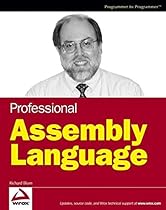Professional Assembly Language

| Author | : | |
| Rating | : | 4.57 (811 Votes) |
| Asin | : | 0764579010 |
| Format Type | : | paperback |
| Number of Pages | : | 576 Pages |
| Publish Date | : | 2015-03-14 |
| Language | : | English |
DESCRIPTION:
During that time, he has had the opportunity to program utilities in various programming languages: C, C++, Java, and Microsoft VB.NET and C#. (Of course, this was back in the eight-bit processor days.) He also has a master of science degree in management from Purdue University, specializing in Management Information Systems. . With this experience, Rich has often found the benefit of reviewing as
This book shows you how to view the assembly language code generated by the compiler and understand how it is created. It shows how to decipher the compiler-generated assembly language code, and how to make functions in your programs faster and more efficient to increase the performance of an application.What you will learn from this book:The benefits of examining the assembly language code generated from your high-level language programHow to create stand-alone assembly language programs for the Linux Pentium environmentWays to incorporate advanced functions and libraries in assembly language programsHow to incorporate assembly language routines in your C and C++ applicationsWays to use Linux system calls in your assembly language programsHow to utilize Pentium MMX and SSE functions in your applications. With t
Unlike high-level languages such as Java and C++, assembly language is much closer to the machine code that actually runs computers; it's used to create programs or modules that are very fast and efficient, as well as in hacking exploits and reverse engineeringCovering assembly language in the Pentium microprocessor environment, this code-intensive guide shows programmers how to create stand-alone assembly language programs as well as how to incorporate assembly language libraries or routines into existing high-level applicationsDemonstrates how to manipulate data, incorporate advanced functions and libraries, and maximize application performanceExamples use C as a high-level language, Linux as the development environment, and GNU tools for assembling, compiling, linking, and debugging
"Good at explaining the basics" according to Yuri Slobodyanyuk. About the syntax used - yes,through all the book only the AT&T assembly syntax is used. The obvious reason is that most popular compiler on Linux is GCC, which has GAS (GNU Assembler) as the behind the scenes assembler invoked by GCC every time you compile your code. And native to GAS is the AT&T syntax and not the Intel syntax, which is deemed more readable.Now to the book contents. As there is no previous knowledge of assembly as. "Explains the trivial, misses the essentials; Not for those who REALLY want to learn Assembly Language." according to Paco Garcia. The reason why I bought this book was because I have loved some of the books published by Wrox for years and I thought that I could use this book to learn the essentials of Assembly Language and what I can do with it. As with all books from all publishers, there will always be some "hits" and "misses". Unfortunately, for Wrox (and for me), this is one of the "misses" for me.Let me start off with the title; this is NOT worthy of the. programmer_in_santamonica This book should not carry the word Professional in the title - it is basic - very basic at best. This book is all about the Intel architecture - e.g. Intel processors. The target audience for this book - as stated in the introduction - is C/C++ programmers interested in converting their (Linux) C/C++ programs to assembly language. Consider this book if you know nothing of assembly language and you want to play around with it in a
